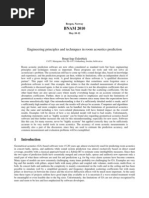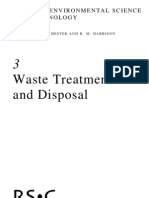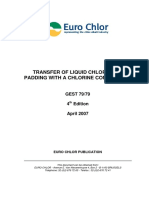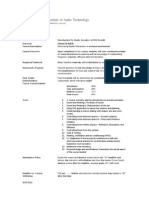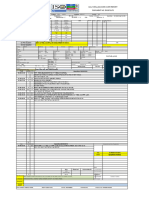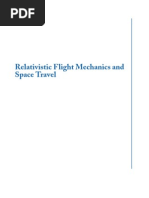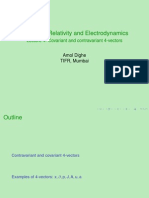15 - GEST 92 171 Edition 6 - Personal Protective Equipment in The Chlorine Industry
Uploaded by
Ademilson JuniorCopyright:
Available Formats
15 - GEST 92 171 Edition 6 - Personal Protective Equipment in The Chlorine Industry
Uploaded by
Ademilson JuniorOriginal Title
Copyright
Available Formats
Share this document
Did you find this document useful?
Is this content inappropriate?
Copyright:
Available Formats
15 - GEST 92 171 Edition 6 - Personal Protective Equipment in The Chlorine Industry
Uploaded by
Ademilson JuniorCopyright:
Available Formats
Personal Protective Equipment in the
Chlorine Industry
GEST 92/171
6th Edition
September 2019
EURO CHLOR PUBLICATION
This document can be obtained from:
EURO CHLOR – Rue Belliard 40 box 15 B-1040 BRUSSELS
E-mail: eurochlor@cefic.be Internet: http://www.eurochlor.org
GEST 92/171
6th Edition
Euro Chlor
Euro Chlor is the European Federation which represents the producers of
chlorine and its primary derivatives.
Euro Chlor is working to:
• Improve awareness and understanding of the contribution that chlorine
chemistry has made to the thousands of products, which have improved
our health, nutrition, standard of living and quality of life;
• Maintain open and timely dialogue with regulators, politicians,
scientists, the media and other interested stakeholders in the debate
on chlorine;
• Ensure our industry contributes actively to any public, regulatory or
scientific debate and provides balanced and objective science-based
information to help answer questions about chlorine and its derivatives;
• Promote the best safety, health and environmental practices in the
manufacture, handling and use of chlor-alkali products in order to
assist our members in achieving continuous improvements (Responsible
Care).
***********
This document has been produced by the members of Euro Chlor and should not be reproduced in
whole or in part without the prior written consent of Euro Chlor.
It is intended to give only guidelines and recommendations. The information is provided in good
faith and was based on the best information available at the time of publication. The
information is to be relied upon at the user’s own risk. Euro Chlor and its members make no
guarantee and assume no liability whatsoever for the use and the interpretation of or the
reliance on any of the information provided.
This document was originally prepared in English by our technical experts. For our members’
convenience, it may have been translated into other EU languages by translators / Euro Chlor
members. Although every effort was made to ensure that the translations were accurate, Euro
Chlor shall not be liable for any losses of accuracy or information due to the translation process.
Prior to 1990, Euro Chlor’s technical activities took place under the name BITC (Bureau
International Technique du Chlore). References to BITC documents may be assumed to be to
Euro Chlor documents.
September 2019 Page 2 of 20
GEST 92/171
6th Edition
RESPONSIBLE CARE IN ACTION
Chlorine is essential in the chemical industry and consequently there is a need
for chlorine to be produced, stored, transported and used. The chlorine industry
has co-operated over many years to ensure that its activities cause the minimum
harm to the well-being of its employees, local communities and the wider
environment. This document is one in a series which the European producers,
acting through Euro Chlor, have drawn up to promote continuous improvement in
the general standards of health, safety and the environment associated with
chlorine manufacture in the spirit of Responsible Care.
The voluntary recommendations, techniques and standards presented in these
documents are based on the experiences and best practices adopted by member
companies of Euro Chlor at their date of issue. They can be taken into account in
full or partially, whenever companies decide it individually, in the operation of
existing processes and in the design of new installations. They are in no way
intended as a substitute for the relevant national or international regulations
which should be fully complied with.
It has been assumed in the preparation of these publications that the users will
ensure that the contents are relevant to the application selected and are
correctly applied by appropriately qualified and experienced people for whose
guidance they have been prepared. The contents are based on the most
authoritative information available at the time of writing and on good
engineering, medical or technical practice but it is essential to take account of
appropriate subsequent developments or legislation. As a result, the text may be
modified in the future to incorporate evolution of these and other factors.
This edition of the document has been drawn up by the GEST (Safety Working
Group) to whom all suggestions concerning possible revision should be addressed
through the offices of Euro Chlor.
September 2019 Page 3 of 20
GEST 92/171
6th Edition
Summary of the Main Modifications in this version
Update on references
TABLE OF CONTENTS
1. FIELD OF APPLICATION 5
2. PROTECTIVE BREATHING EQUIPMENT 5
2.1. The Mask 6
2.2. The Filter 8
2.2.1. Use of filters 9
2.2.2. Filter saturation 9
2.2.3. Storage of Filters 10
2.2.4. Standard Type of Filter for Chlorine 10
2.3. Self-Contained Breathing Apparatus - S.C.B.A. 10
2.3.1. Closed-Circuit Apparatus 10
2.3.2. Open-Circuit Breathing Apparatus 11
3. MAINTENANCE OF THE BREATHING EQUIPMENT 14
3.1. Masks 14
3.2. The Self-Breathing Equipment 14
4. BODY PROTECTION 15
4.1. Helmet, Boots and Gloves 15
4.2. Full Protective Clothing: Suits 15
5. OTHER PROTECTIVE EQUIPMENT 17
5.1. Eyes Protection 17
5.2. Electric Risk Protection 19
September 2019 Page 4 of 20
GEST 92/171
6th Edition
1. FIELD OF APPLICATION
This Recommendation is intended to provide information on most types of
personal protective equipment used in the manufacturing and handling of
chlorine, caustic (soda or potash), sulphuric/hydrochloric acid.
Chlorine is a toxic element, gaseous in ambient conditions, with highly irritating
effects on:
➢ The respiratory organs;
➢ The eyes;
➢ The skin.
Since the consequences of chlorine inhalation are immediate and can be
extremely serious, particular attention has been given to this aspect and the
protective methods required. These are described in specific chapters.
Caustic is usually present as aqueous solution, corrosive for eyes and skin. It can
also exist as solid, implying that during handling, dust can be accidentally
inhaled or come in contact with skin or eyes. An important factor to consider is
that the effect of exposure of the body is not always directly noticed which will
increase the severity of the injury due to the possible delay in intervention.
The protection against caustic has been included in the last Chapter covering
also briefly the protection against other more common chemicals used in the
chlorine industry (sulphuric and hydrochloric acids, hypochlorite, hydrogen
peroxide etc.).
This last chapter includes also the information to protect workers against the
specific electric risks in cell rooms and power supply area.
The different types of equipment mentioned in this paper are those generally
found in the chlorine industry.
2. PROTECTIVE BREATHING EQUIPMENT
There are two main types of equipment:
➢ Breathing apparatus with filters,
➢ Self-contained breathing apparatus.
Both groups use a common type of device: the mask (which is different for non-
pressurised and pressurised systems).
The assigned protection factor (APF) of a respirator reflects the level of
protection that a properly functioning respirator would be expected to provide
to a population of properly fitted and trained users. For example, an APF of 10
for a respirator means that a user could expect to inhale no more than one tenth
of the airborne contaminant present.
September 2019 Page 5 of 20
GEST 92/171
6th Edition
Various organisations, such as the National Institute for Occupational Safety and
Health (NIOSH), the Occupational Safety and Health Administration (OSHA), the
American National Standards Institute (ANSI), The British Standards Institution
(BSI), and the Dutch Occupational Hygiene Society (DOHS) have proposed factors
for the different types of respirators available and these can be consulted for
the choice of the most appropriate protective solutions:
(http://www.osha.gov/pls/oshaweb/owadisp.show_document?p_table=STANDAR
DS&p_id=12716#1910.134(d)(3)(i)(A) for OSHA).
For all these systems, regular training of operators is mandatory!
2.1. The Mask
The mask ensures the proper protection of the respiratory organs, eyes and face.
It is typically made up of the following elements (see Figure 1):
Figure 1: The mask
1. "Skirt"
2. Sealing lips
3. Glass
4. Interior half-mask
5. Head straps
6. Connection
7. Expiration valve
8. Inspiration valve on interior
half-mask
9. Inspiration valve
10. Phonic membrane
Figure 2: Panoramic mask
September 2019 Page 6 of 20
GEST 92/171
6th Edition
The panoramic mask is generally available in 3 different sizes so that it can suit
most users.
The seal depends almost exclusively on the "skirt" around the face; certain types
of skirts are equipped with sealing lips to improve tightness.
Due to face shape or facial hair, some people have difficulty in obtaining a
perfect seal. All users shall ensure they can maintain a perfect seal around their
mask prior to each use.
Almost all models can be equipped with special spectacle frames for use with
corrective lenses (Figures 3 below). With these spectacles, air-tightness is
optimal due to the absence of arms going all the way to the ears. However, the
spectacles position can be very fragile and lead to a decrease of vision comfort
(especially for people with stigmatisms). The use of ultraflat arms spectacles
going all the way to the ears is able to avoid this position problem, without
noticeable change of air-tightness, especially if the mask is a pressurised one.
Figure 3: Mask equipped with spectacles
The mask is fixed with a set of adjustable head straps or a net, which is more
comfortable; both systems permit the use of a helmet.
Certain parts of the mask need particular attention:
➢ The glass: which must be resistant to impact of liquid chlorine droplets at
minus 30°C or colder;
➢ The microphone: when present, must be resistant to corrosion by
chlorine. Metallic membranes are preferable (certain plastic membranes
showed good performance however);
➢ The outlet valve: this is the only device which connects the inside of the
mask with the outside polluted air. It must be absolutely tight. It is
September 2019 Page 7 of 20
GEST 92/171
6th Edition
preferable to use a mask with a large outlet valve chamber to avoid toxic
gases entering the mask while breathing in.
The buyer should ensure that the mask is suitable for chlorine and conforms to
any national or company standard.
Remark: there are escape masks that do not protect the eyes (see Figure 4
below). These should only be used in the case of an emergency evacuation. They
are called 'Escape Masks". Escape masks must never be used for any
intervention!
Figure 4: Escape mask with its protective housing
2.2. The Filter
The filter, or cartridge, (Figure 5) is connected to the mask and absorbs
contaminants on active carbon during inhalation.
There must be no components present above occupational exposure level for
which the filter is not effective, e.g. less than 25 ppm CO (carbon monoxide).
Figure 5: Filters (cartridges) for chlorine (B)
September 2019 Page 8 of 20
GEST 92/171
6th Edition
The first mask on the left is also protecting against organic vapours (A) and the
other one against alkalis (K) (see point 2.2.4 below).
2.2.1. Use of filters
With this type of equipment, protection is obtained only if the three following
conditions are met:
➢ Filter or cartridge suitable for chlorine;
➢ Oxygen content at least 19% volume. Make sure oxygen content is
sufficient;
➢ Depending on their size, chlorine filters on full face mask are normally
designed to remove chlorine at concentrations up to 1000 ppm volume
which provide a high level of protection; additionally, to the
concentration of chlorine in air, the maximum allowed duration of the
exposure will depend on several factors including breathing frequency,
volume inhaled, air moisture etc. (check manufacturer specifications).
However, a filter mask is normally only used in the following
circumstances:
o Where there is no chlorine present, but presence of chlorine is a
possibility, for example: making tankers connections or breaking
flanges (and any immediate actions after a consequent release);
o For maintenance and leak testing during commissioning;
o For escape purposes.
This type of equipment can sometimes be used to locate minor leaks if the
concentration of chlorine is very low (less than 10 ppm, monitored with a
portable detector).
For all other situations, self-contained breathing apparatus should be worn.
2.2.2. Filter saturation
In addition to its intrinsic absorption variability, filter life depends on the
concentration of the contaminating gases and of the breathing rate. It is also
influenced by secondary factors such as other contaminants, humidity (moisture
content above 85% will reduce service life by 50%) or temperature (if increased,
absorption capacity is reduced) of the inhaled air.
The effective life of a filter can therefore not be specified. However, a number
of signs show when the cartridges have to be changed:
➢ Breathing difficulties occur because of restricted air flow;
➢ Smell of the gas through the filter means saturation (criteria cannot be
used in the case of hydrogen sulphide H2S which is an olfactory
anaesthetic);
Note that the reaction of active charcoal with oxygen and chlorine may yield
phosgene (carbonyl chloride COCl2), which is retained by the filter until
saturation. An operator who has been exposed to chlorine due to a saturated
filter should be examined for symptoms of an exposition to phosgene.
September 2019 Page 9 of 20
GEST 92/171
6th Edition
After each chlorine exposure, the cartridge should be changed.
2.2.3. Storage of Filters
The filter should not be used after expiry date marked on it by the
manufacturer. It varies according to the type of filter, usually between 4 to 6
years.
Any unused filter which has been opened must be replaced within 6 months.
2.2.4. Standard Type of Filter for Chlorine
The suitable type is B. This type can be associated with other protection: A
(organics), K (alkalis like ammonia and amines) and/or E (dust) shown in the
following diagram.
ABEK
AB BKE
A B K E
Organics Acidic gases Amonia Dust
• Chlorine Amines
• Hydrochloric acid
• Phosgene
Nitrous oxides
Hydrogen sulphide*
* Be aware that H2S is an olfactory anaesthetic and that smell cannot be used to
indicate breakthrough.
2.3. Self-Contained Breathing Apparatus - S.C.B.A.
This equipment enables the user to work in a highly contaminated atmosphere
without using ambient air.
There are two types of self-contained breathing apparatus:
➢ Closed circuit apparatus: the expired air is purified of its carbon dioxide,
enriched with oxygen from a bottle contained within the equipment and
re-injected into the breathing circuit;
➢ Open-circuit apparatus: the expired air is exhausted through a valve into
the ambient air.
2.3.1. Closed-Circuit Apparatus
The advantage of this type of equipment is its large autonomy. There are,
however, three disadvantages for the user:
September 2019 Page 10 of 20
GEST 92/171
6th Edition
➢ The inhaled air is warm due to recycling, leading to some discomfort;
➢ The mask is not permanently pressurised and does not therefore
guarantee absolute imperviousness;
➢ The maintenance is more complex.
In view of these drawbacks, the details of this type of apparatus have not been
developed any further in this recommendation.
2.3.2. Open-Circuit Breathing Apparatus
The air is used only once; there are three types of open-circuit breathing
apparatus:
➢ Self-contained apparatus;
➢ Apparatus with external air supply;
➢ Combined apparatus.
The breathing air must be free of unwanted contaminants and must comply with
the requirements of breathing air (oxygen of 19 to 23 %; hydrocarbons
(condensed) of 5 mg/m3 or less; carbon monoxide may not exceed 10 ppm;
carbon dioxide not higher than 1000 ppm; lack of noticeable odour). The
location of the compressor intake is critical to the purity of the compressed air.
The compressor must be located in an area uncontaminated by either
combustion exhaust gases or by other gases from plant processes. Compressors
should be equipped with in-line air purifying sorbent beds, filters and detection
systems, if needed, to ensure breathing air quality.
2.3.2.1. The self-contained apparatus
The user carries on his back one or two bottles of compressed air. This
equipment gives him mobility and autonomy. Users must be trained and certified
to use.
The disadvantage is a limited autonomy (10 to 30 minutes).
There are two systems:
➢ Permanently pressurised (Figure 6 below). The mask is maintained
permanently at a slight pressure of a few millibars above ambient
pressure regardless the breathing rate of the user. Loss of air due to poor
seal will be compensated by the pressure control thus preventing toxic gas
from entering.
➢ The exhaust valve, built into the mask, is calibrated for a pressure of a
few millibars. This mask is therefore specific for this type of breathing
apparatus.
September 2019 Page 11 of 20
GEST 92/171
6th Edition
Figure 6: Self-contained apparatus
➢ With air supply actuator. The air supply is activated by the user; because
the mask is not permanently pressurised, care must be taken to ensure a
good seal between the mask and the face.
An alarm for low pressure in the air bottles is necessary for both systems.
2.3.2.2. Apparatus with external air supply
The user is connected to an air supply (usually a bottle bank or a dedicated
breathing air network) via a hose. His mobility is limited to the length of the
hose which must not exceed 50 m.
This type of apparatus gives a large degree of autonomy for fixed work places.
They may also be used for longer continuous periods. The breathing resistance
and discomfort are minimal, and the system requires moderate initial costs and
relatively low operating costs. The temperature of the breathing air can also be
controlled (cool in hot periods and warm in cold seasons). On the other hand,
the trailing air supply severely restricts the wearer's mobility and may fail due to
hose damage.
September 2019 Page 12 of 20
GEST 92/171
6th Edition
Figure 7: External air supply
This apparatus is sometimes equipped with a small air bottle to act as a back-up
in case of failure of the main air supply. If necessary, the user can disconnect
from the external supply and function autonomously, the mask remaining under
air supply during the time needed for evacuation. An alarm to indicate when the
spare air bottle is in use is an important safety feature.
For safety reasons, the air supply must be dedicated to this purpose with no
cross connection with any other gasses supply and use (including other air
supplies). The hose connection must be of a particular type of connection which
prevents use for other purposes.
2.3.2.3. Combined systems
This equipment is made up of two different, but complementary devices. The
first one is a jacket with emergency equipment (small capacity bottle) as
described above; the second is a self-contained apparatus. A rapid safety
coupling connects the two apparatus together.
The operator uses either a self-contained apparatus or equipment with a
permanent air supply during connection and disconnection operations.
September 2019 Page 13 of 20
GEST 92/171
6th Edition
Depending if the system is pressurised or not, these apparatus provide an over-
pressure or not.
With this equipment, the operator can penetrate a toxic atmosphere and reach
the work place connected to an air supply. Once connected to this supply, the
operator can then disconnect the self-contained equipment. A filter is then
necessary to ensure the safe switching from one system to the other.
In case of emergency, the operator can escape using the emergency spare
bottle.
The advantages of this equipment are:
➢ An overpressure in both functions.
➢ Enables the user to work with unlimited autonomy.
3. MAINTENANCE OF THE BREATHING EQUIPMENT
3.1. Masks
In places where the mask is often used, it is necessary to personalise the
protective equipment. The same applies for masks containing corrective lenses.
On receiving his mask, the user must check the seal. This is done by blocking the
air-intake with the palm of the hand and checking that the mask presses against
the face during inhalation.
When the mask is used collectively, it must be cleaned and disinfected after
each use according to the supplier's recommendations.
Masks must be identified and located in order to keep track of their maintenance
and use.
At least once a year, and preferably twice, a tightness test must be made. This
test, as well as cleaning, disinfection and maintenance must be carried out
according to supplier's instructions and by specialised and conscientious people.
3.2. The Self-Breathing Equipment
This equipment must be identified, located and regularly checked.
Suppliers offer their services:
➢ Either to perform these tests themselves;
➢ Or the electronic maintenance equipment needed to check, collect and
store all the parameters of the equipment (including check for low
pressure alarm).
Air bottles must also be checked periodically in addition to the periodic tests
required by pressure-vessel regulations:
➢ Check pressure before each use;
September 2019 Page 14 of 20
GEST 92/171
6th Edition
➢ Replace the bottle systematically after use.
The pressure in the spare air bottles must also be checked so as to ensure
tightness of the high-pressure valves.
4. BODY PROTECTION
4.1. Helmet, Boots and Gloves
Independently of the protection against chlorine, workers have to wear a
protective helmet wherever there is a potential risk of falling objects. Work
clothes covering arms and legs and safety shoes are also mandatory for workers
in the whole production area.
When working on process equipment (opening lines …) containing corrosive
products (NaOH, H2SO4, HCl …), rubber safety boots should be worn, but specific
precaution should be taken if the worker can be exposed to electric risk (see
below).
Additionally, tight chemical resistant gloves must be used during interventions
dealing with all corrosive chemicals. Sewn and permeable gloves are prohibited.
4.2. Full Protective Clothing: Suits
Working in a chlorine-filled atmosphere involves the use of impervious, full
protective clothing because:
➢ Splashing of liquid chlorine, in certain circumstances, cannot be ruled
out;
➢ Chlorine causes irritation of the skin on damp parts of the body (armpits,
genitals, feet);
➢ Chlorine impregnated personal clothing can cause inconvenience when the
operator takes off his breathing equipment.
Even if irritation of the eye, when exposed to gaseous chlorine, begins to occur
at the 1-10 ppm level, the effects of skin start at a higher concentration.
Gaseous chlorine absorbs in water to form both hypochlorous and hydrochloric
acids. Chlorine gas can dissolve in body moisture (i.e., perspiration) to form
these acids. At high chlorine concentration in air, the pH of moisture on the skin
and mucous tissues will decrease. While a burning sensation and skin irritation
can occur due to such exposure, a review of the literature has provided no
specific human data to determine the concentration of chlorine required to
produce such effects.
Usually accurate concentration measurement is not possible due to the lack of
time (necessity for urgent intervention), the non-homogeneity of the
atmosphere, and the changes in concentration as times goes by. As a
consequence, the decision to wear full protective clothing will be taken by the
intervention leader based on his assessment of the situation, avoiding exposing
his team to unacceptable risk, especially in the presence of liquid chlorine,
September 2019 Page 15 of 20
GEST 92/171
6th Edition
opacity of the gas cloud, burning sensation and skin irritation etc, or following
possible national/local requirements.
The full protective clothing is usually coated with Viton® or Hypalon®. The last
one is also resistant to caustic and inorganic acids.
Different types of full protective clothing are available:
➢ A suit used in conjunction with a non-protected self-contained breathing
apparatus;
➢ A full protective suit (similar to a diver's suit) equipped with mask, with or
without protection of the self-contained breathing apparatus.
The main objective of this protection is the absolute imperviousness of the
mask, gloves, boots, zippers and seams.
Figure 8: Full protective clothing with protected breathing apparatus
Note: even if of different colour, the booths and gloves are integrally sealed to
the full protective equipment.
This tightness has to be regularly checked. For adequate preservation of the
clothing, it is recommended to hang it up because folds may damage it.
For communication, a radio system is recommended.
Alternatively to the model here above, there are full protective gas suits with air
bottles placed outside the equipment.
September 2019 Page 16 of 20
GEST 92/171
6th Edition
Conditions of use
Wearing full protective clothing speeds up thermo-regulation of the body,
especially in warm conditions or when completing heavy work. Interventions
must be interrupted by a period of rest; the duration of intervention and of rest
will depend on several factors (physical status of the worker, external
temperature, type of activity …). The American OSHA has published a guideline
on the subject (OSHA Technical Manual- Section III: Chapter 4 Heat Stress).
During interruption, the complete equipment has to be taken off (alternate
intervention squads). In case of emergency intervention, at least two people
should be equipped. Help is required to put on and remove this full protective
clothing.
After intervention with significant chlorine concentration, the equipment should
be decontaminated in a well-ventilated area (e.g. safety shower).
YOU CANNOT IMPROVISE INTERVENTIONS OF THIS KIND: GOOD PREPARATION
IS A MUST.
This means:
➢ Maintenance of the suit, especially zippers;
➢ Regular training in putting on the suit;
➢ Regular training exercises;
➢ Routine medical checks with a medical approval for all regular users.
5. OTHER PROTECTIVE EQUIPMENT
It is not possible to list all the various kinds of jobs involving chlorine in order to
make up a typical list of the necessary protective equipment.
Apart from chlorine, production personnel must be protected against the risks
from other products such as: caustic soda, potassium hydroxide, hot brine,
steam, hypochlorite, mercury, sulphuric and hydrochloric acids …
The nature of the jobs to be performed will make it possible to establish, in
terms of quality and quantity, the material that has to be put at workers'
permanent disposal, that which has to be handed out in certain cases and the
material that has to be kept in reserve. This must be part of a written
specification.
5.1. Eyes Protection
Safety glasses (see picture below) are strongly recommended in all chemical
plants.
September 2019 Page 17 of 20
GEST 92/171
6th Edition
Safety glasses
For manipulations of caustic or acid (taking samples, loading/off-loading
operations …), for opening lines/equipment where these products have been
present (initial line break), for starting/shutting down pumps and for emergency
response, chemical splash safety goggles with a good face seal are recommended
(see picture here below).
The wearing of such goggles is also recommended in the caustic concentration
unit area, even if no operation is foreseen on lines or equipment.
Safety goggles
The safety glasses and the panoramic goggles allow the use of corrective lenses.
Safety glasses or goggles with additional face shield (see picture below) is also
uses, depending on the specific job risk assessment, for all interventions with a
real potential risk of exposure (opening a connection …) on circuits/equipment
containing corrosive liquids.
Face shield
September 2019 Page 18 of 20
GEST 92/171
6th Edition
An alternative to goggles, when fogging can create problems, is the use of a
ventilated hood fully covering the head and the face.
5.2. Electric Risk Protection
Important note: it is important to precise that this part of the guideline targets
the production workers and not the electricians for which there exist specific
requirements.
Risks of electrical arc must be considered in the cell room and the electric
power supply area where voltages of several hundred volts are present on not-
insulated metallic conductors and cell parts.
It must be reminded that the electrolysis cells behave a bit like an electric
battery, keeping the voltage (and the risk) present for some time after the
power supply has been disconnected.
The access of the zones with electrical hazard should be restricted to authorised
and trained () personnel only. Additionally:
➢ Mechanical barriers or screens should be installed to prevent accidental
contact with electrical live parts (simultaneous and at two different
voltages);
➢ The workers should wear boots or shoes with a low electric conductivity,
which should periodically be tested according to the norms and rules of
the equipment;
➢ For some specific situations, “electrical insulating matting” (cf. IEC
61111) can be used when the worker needs to sit or work with the knee on
the ground.
The high magnetic field found in electrolysis plants requires, whenever possible,
the use of non-magnetic equipment to avoid the “projectile” risk.
The possible health effects of electric and magnetic fields are treated in the
guideline Health 10 – Electromagnetic Fields in the Chlorine Electrolysis
units What an occupational physician should know.
September 2019 Page 19 of 20
GEST 92/171
6th Edition
Industrial consumers of chlorine, engineering and equipment supply companies
worldwide and chlorine producers outside Europe may establish a permanent
relationship with Euro Chlor by becoming Partners.
Details of fees are available from:
Euro Chlor
Rue Belliard 40 Box 15
B-1040 Brussels
Belgium
E-mail: eurochlor@cefic.be
Internet: http://www.eurochlor.org
September 2019 Page 20 of 20
You might also like
- 9 - GEST 17 492 Edition 2 - Specifications and Approval Procedure For Valves To Be Used in Liquid Cl2...100% (1)9 - GEST 17 492 Edition 2 - Specifications and Approval Procedure For Valves To Be Used in Liquid Cl2...84 pages
- Answers. Levels 7/8. Pack 2.: Level 7/8 Pack 2. Answers. Page 1. © Www.10ticks - Co.ukNo ratings yetAnswers. Levels 7/8. Pack 2.: Level 7/8 Pack 2. Answers. Page 1. © Www.10ticks - Co.uk10 pages
- Piping and Instrumentation Diagrams (P&IDs)No ratings yetPiping and Instrumentation Diagrams (P&IDs)40 pages
- Engineering Principles and Techniques in Room Acoustics PredictionNo ratings yetEngineering Principles and Techniques in Room Acoustics Prediction8 pages
- NB-CPD SG10 12 091 - en 771 Series - Evaluation of Conformity For Masonry UnitsNo ratings yetNB-CPD SG10 12 091 - en 771 Series - Evaluation of Conformity For Masonry Units74 pages
- Underwater Optical Wireless CommunicationNo ratings yetUnderwater Optical Wireless Communication30 pages
- Emergency Intervention in Case of Chlorine Leaks: GEST 93/179 9 Edition December 2015No ratings yetEmergency Intervention in Case of Chlorine Leaks: GEST 93/179 9 Edition December 201520 pages
- Chemistry Crunch #13.2: Nuclear Fission & Fusion KEY Why?No ratings yetChemistry Crunch #13.2: Nuclear Fission & Fusion KEY Why?5 pages
- 12 - GEST 80 84 Edition 7 - Commissioning and Decommissioning of Instrallations For Dry Cl2 Gas and LiquidNo ratings yet12 - GEST 80 84 Edition 7 - Commissioning and Decommissioning of Instrallations For Dry Cl2 Gas and Liquid16 pages
- Small Chlorine Containers Construction and Handling100% (3)Small Chlorine Containers Construction and Handling40 pages
- 14 - GEST 90 162 Edition 6 - Emergency Transfer of Liquid ChlorineNo ratings yet14 - GEST 90 162 Edition 6 - Emergency Transfer of Liquid Chlorine21 pages
- GEST 75 47 Edition 11design and Operation of Chlorine VaporisersNo ratings yetGEST 75 47 Edition 11design and Operation of Chlorine Vaporisers28 pages
- Commissioning and Decommissioning of Installations For Dry Chlorine Gas and LiquidNo ratings yetCommissioning and Decommissioning of Installations For Dry Chlorine Gas and Liquid18 pages
- Wet and Dry Scrubbers Section 5 Chapter 1 Control Cost Manual 7th EditionNo ratings yetWet and Dry Scrubbers Section 5 Chapter 1 Control Cost Manual 7th Edition122 pages
- Four Steps: To Recovering Heat Energy From WastewaterNo ratings yetFour Steps: To Recovering Heat Energy From Wastewater3 pages
- Waste Treatment and Disposal - R. Hester, R. Harrison (1995) WWNo ratings yetWaste Treatment and Disposal - R. Hester, R. Harrison (1995) WW161 pages
- Download Complete Acoustics for Engineers 3rd Edition Troy Lectures PDF for All Chapters100% (12)Download Complete Acoustics for Engineers 3rd Edition Troy Lectures PDF for All Chapters43 pages
- GEST 79 79 Edition 4 (Transfer of Liquid Chlorine by Padding With A Chlorine Compressor)No ratings yetGEST 79 79 Edition 4 (Transfer of Liquid Chlorine by Padding With A Chlorine Compressor)15 pages
- Life Cycle Assesment of Beer Production in GreeceNo ratings yetLife Cycle Assesment of Beer Production in Greece7 pages
- Bachmann Sheehan 71: and TR Lzs-A 7-Pregnadiene-3No ratings yetBachmann Sheehan 71: and TR Lzs-A 7-Pregnadiene-34 pages
- Acoustic Induced Vibration (AIV) FatigueNo ratings yetAcoustic Induced Vibration (AIV) Fatigue4 pages
- Environmental Challenges in Petroleum IndustryNo ratings yetEnvironmental Challenges in Petroleum Industry21 pages
- 49 CFR Ch. I (10-1-04 Edition) 180.205: 180.205 General Requirements For Re-Qualification of CylindersNo ratings yet49 CFR Ch. I (10-1-04 Edition) 180.205: 180.205 General Requirements For Re-Qualification of Cylinders4 pages
- Get The Syntax of Roots and The Roots of Syntax 1st Edition Alexiadou Free All Chapters100% (13)Get The Syntax of Roots and The Roots of Syntax 1st Edition Alexiadou Free All Chapters41 pages
- Cópia de Skincare & Beauty Infographics by SlidesgoNo ratings yetCópia de Skincare & Beauty Infographics by Slidesgo52 pages
- 10 - GEST 73 25 Edition 13 - Transfer of Dry Chlorine by Piping SystemsNo ratings yet10 - GEST 73 25 Edition 13 - Transfer of Dry Chlorine by Piping Systems31 pages
- 11 - GEST 78 73 Edition 9 - Design Principles and Operational, Procedures For Loading Off-Loading Liquid Cl2 Road Rail TankersNo ratings yet11 - GEST 78 73 Edition 9 - Design Principles and Operational, Procedures For Loading Off-Loading Liquid Cl2 Road Rail Tankers24 pages
- 13 - GEST 87 133 Edition 6 - Overpressure Relief of Chlorine InstallationsNo ratings yet13 - GEST 87 133 Edition 6 - Overpressure Relief of Chlorine Installations15 pages
- 6 - GEST 17 492 Edition 2 - Appendix 3 Logic Diagram For Euro Chlor Valve Certification Procedure100% (1)6 - GEST 17 492 Edition 2 - Appendix 3 Logic Diagram For Euro Chlor Valve Certification Procedure1 page
- 250 TOP Fluid Mechanics - Mechanical Engineering Multiple Choice Questions and Answers List - MCQs Preparation For Engineering Competitive Exams100% (1)250 TOP Fluid Mechanics - Mechanical Engineering Multiple Choice Questions and Answers List - MCQs Preparation For Engineering Competitive Exams22 pages
- Thermal and Spectroscopic Investigation of Sol-Gel Derived Aluminosilicate Bioglass MatricesNo ratings yetThermal and Spectroscopic Investigation of Sol-Gel Derived Aluminosilicate Bioglass Matrices5 pages
- DocumentMSA Portable Gas Detection Methane As A Pentane Simulant vs. Pentane CalibrationNo ratings yetDocumentMSA Portable Gas Detection Methane As A Pentane Simulant vs. Pentane Calibration2 pages
- Daily Drilling Report - 29-03-2019 - WSW-27No ratings yetDaily Drilling Report - 29-03-2019 - WSW-271 page
- Relativistic Flight Mechanics and Space Travel100% (1)Relativistic Flight Mechanics and Space Travel140 pages
- 2017 Structural Concrete Using Sintered Flyash Lightweight AggregateNo ratings yet2017 Structural Concrete Using Sintered Flyash Lightweight Aggregate17 pages
- Dimethyl Sulfoxide: A Solvent Safe For Man and The EnvironmentNo ratings yetDimethyl Sulfoxide: A Solvent Safe For Man and The Environment6 pages
- Heat Transfer: Anna University Question BankNo ratings yetHeat Transfer: Anna University Question Bank6 pages
- Lecture 1 Atomic and Nuclear Physics (M)No ratings yetLecture 1 Atomic and Nuclear Physics (M)81 pages
- Module II: Relativity and Electrodynamics: Lecture 4: Covariant and Contravariant 4-VectorsNo ratings yetModule II: Relativity and Electrodynamics: Lecture 4: Covariant and Contravariant 4-Vectors19 pages
- Heat Transfer Coefficient in A Shallow Fluidized Bed Heat Exchanger With A Continuous Flow of Solid ParticlesNo ratings yetHeat Transfer Coefficient in A Shallow Fluidized Bed Heat Exchanger With A Continuous Flow of Solid Particles6 pages
- Dehydrogenation To Produce Propylene From PropaneNo ratings yetDehydrogenation To Produce Propylene From Propane3 pages
- 9 - GEST 17 492 Edition 2 - Specifications and Approval Procedure For Valves To Be Used in Liquid Cl2...9 - GEST 17 492 Edition 2 - Specifications and Approval Procedure For Valves To Be Used in Liquid Cl2...
- Answers. Levels 7/8. Pack 2.: Level 7/8 Pack 2. Answers. Page 1. © Www.10ticks - Co.ukAnswers. Levels 7/8. Pack 2.: Level 7/8 Pack 2. Answers. Page 1. © Www.10ticks - Co.uk
- Engineering Principles and Techniques in Room Acoustics PredictionEngineering Principles and Techniques in Room Acoustics Prediction
- NB-CPD SG10 12 091 - en 771 Series - Evaluation of Conformity For Masonry UnitsNB-CPD SG10 12 091 - en 771 Series - Evaluation of Conformity For Masonry Units
- Emergency Intervention in Case of Chlorine Leaks: GEST 93/179 9 Edition December 2015Emergency Intervention in Case of Chlorine Leaks: GEST 93/179 9 Edition December 2015
- Chemistry Crunch #13.2: Nuclear Fission & Fusion KEY Why?Chemistry Crunch #13.2: Nuclear Fission & Fusion KEY Why?
- 12 - GEST 80 84 Edition 7 - Commissioning and Decommissioning of Instrallations For Dry Cl2 Gas and Liquid12 - GEST 80 84 Edition 7 - Commissioning and Decommissioning of Instrallations For Dry Cl2 Gas and Liquid
- Small Chlorine Containers Construction and HandlingSmall Chlorine Containers Construction and Handling
- 14 - GEST 90 162 Edition 6 - Emergency Transfer of Liquid Chlorine14 - GEST 90 162 Edition 6 - Emergency Transfer of Liquid Chlorine
- GEST 75 47 Edition 11design and Operation of Chlorine VaporisersGEST 75 47 Edition 11design and Operation of Chlorine Vaporisers
- Commissioning and Decommissioning of Installations For Dry Chlorine Gas and LiquidCommissioning and Decommissioning of Installations For Dry Chlorine Gas and Liquid
- Wet and Dry Scrubbers Section 5 Chapter 1 Control Cost Manual 7th EditionWet and Dry Scrubbers Section 5 Chapter 1 Control Cost Manual 7th Edition
- Four Steps: To Recovering Heat Energy From WastewaterFour Steps: To Recovering Heat Energy From Wastewater
- Waste Treatment and Disposal - R. Hester, R. Harrison (1995) WWWaste Treatment and Disposal - R. Hester, R. Harrison (1995) WW
- Download Complete Acoustics for Engineers 3rd Edition Troy Lectures PDF for All ChaptersDownload Complete Acoustics for Engineers 3rd Edition Troy Lectures PDF for All Chapters
- GEST 79 79 Edition 4 (Transfer of Liquid Chlorine by Padding With A Chlorine Compressor)GEST 79 79 Edition 4 (Transfer of Liquid Chlorine by Padding With A Chlorine Compressor)
- 49 CFR Ch. I (10-1-04 Edition) 180.205: 180.205 General Requirements For Re-Qualification of Cylinders49 CFR Ch. I (10-1-04 Edition) 180.205: 180.205 General Requirements For Re-Qualification of Cylinders
- Get The Syntax of Roots and The Roots of Syntax 1st Edition Alexiadou Free All ChaptersGet The Syntax of Roots and The Roots of Syntax 1st Edition Alexiadou Free All Chapters
- Cópia de Skincare & Beauty Infographics by SlidesgoCópia de Skincare & Beauty Infographics by Slidesgo
- 10 - GEST 73 25 Edition 13 - Transfer of Dry Chlorine by Piping Systems10 - GEST 73 25 Edition 13 - Transfer of Dry Chlorine by Piping Systems
- 11 - GEST 78 73 Edition 9 - Design Principles and Operational, Procedures For Loading Off-Loading Liquid Cl2 Road Rail Tankers11 - GEST 78 73 Edition 9 - Design Principles and Operational, Procedures For Loading Off-Loading Liquid Cl2 Road Rail Tankers
- 13 - GEST 87 133 Edition 6 - Overpressure Relief of Chlorine Installations13 - GEST 87 133 Edition 6 - Overpressure Relief of Chlorine Installations
- 6 - GEST 17 492 Edition 2 - Appendix 3 Logic Diagram For Euro Chlor Valve Certification Procedure6 - GEST 17 492 Edition 2 - Appendix 3 Logic Diagram For Euro Chlor Valve Certification Procedure
- 250 TOP Fluid Mechanics - Mechanical Engineering Multiple Choice Questions and Answers List - MCQs Preparation For Engineering Competitive Exams250 TOP Fluid Mechanics - Mechanical Engineering Multiple Choice Questions and Answers List - MCQs Preparation For Engineering Competitive Exams
- Thermal and Spectroscopic Investigation of Sol-Gel Derived Aluminosilicate Bioglass MatricesThermal and Spectroscopic Investigation of Sol-Gel Derived Aluminosilicate Bioglass Matrices
- DocumentMSA Portable Gas Detection Methane As A Pentane Simulant vs. Pentane CalibrationDocumentMSA Portable Gas Detection Methane As A Pentane Simulant vs. Pentane Calibration
- 2017 Structural Concrete Using Sintered Flyash Lightweight Aggregate2017 Structural Concrete Using Sintered Flyash Lightweight Aggregate
- Dimethyl Sulfoxide: A Solvent Safe For Man and The EnvironmentDimethyl Sulfoxide: A Solvent Safe For Man and The Environment
- Module II: Relativity and Electrodynamics: Lecture 4: Covariant and Contravariant 4-VectorsModule II: Relativity and Electrodynamics: Lecture 4: Covariant and Contravariant 4-Vectors
- Heat Transfer Coefficient in A Shallow Fluidized Bed Heat Exchanger With A Continuous Flow of Solid ParticlesHeat Transfer Coefficient in A Shallow Fluidized Bed Heat Exchanger With A Continuous Flow of Solid Particles



